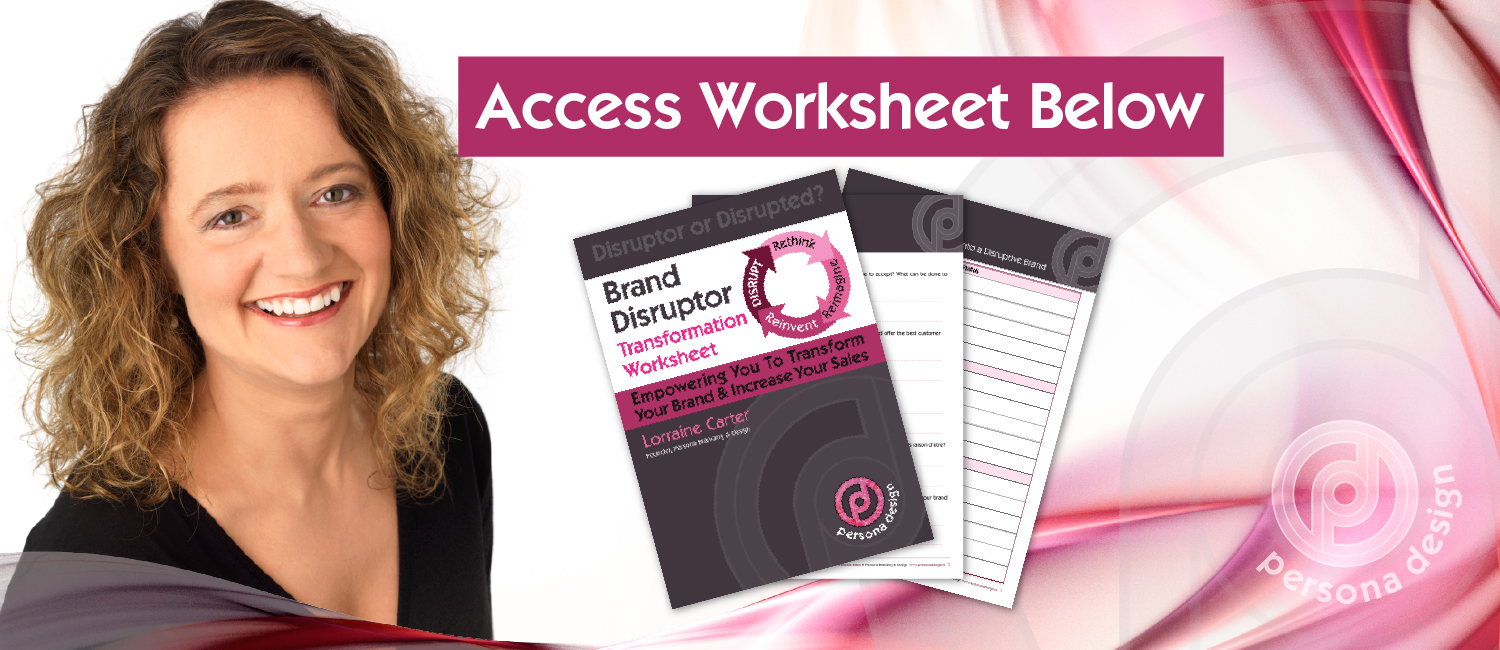Brand Disruption as a Business Framework for Future Growth
In an array of branding terms, disruptive branding stands separately. While terms such as brand values, brand positioning, brand identity occupy a definite space in the branding realm and relate to all the different ways companies use branding to build, promote and sell their products, brand disruption is different. Brand disruption isn’t a practice businesses engage in after the company or product is born. Brand disruption gives birth to the company.
Business owners often involve brand consultants when the idea of the company is already fully formed, but the story that will hook the customer is still in the works. In such cases, the story serves the purpose of relaying the brand’s message to the audience, preferably in emotional and aspirational terms. Unlike a brand’s promotional efforts, brand disruption isn’t an afterthought. Brand disruption doesn’t aim to explain, inspire, educate, or sell something that has already been created. It forms the core of the company’s offering and thus explains, inspires, educates and sells on its own.
Related: Why Do I Need A Brand? I’ve Got A Great Product and a Logo
Disruptive branding can’t be examined separately from the business because it fuses many elements that are a broader part of branding such as business model, customer experience, product, and growth tactics.
Looking to reinvent your brand for brand disruption? Take a look at our Brand Revitalisation service. Brands are constantly evolving to ensure they keep abreast of changing needs in the marketplace. It’s the level of change required that is the critical issue. A brand audit and market research during Brand Revitalisation will help assess the rate of change required amongst other things.
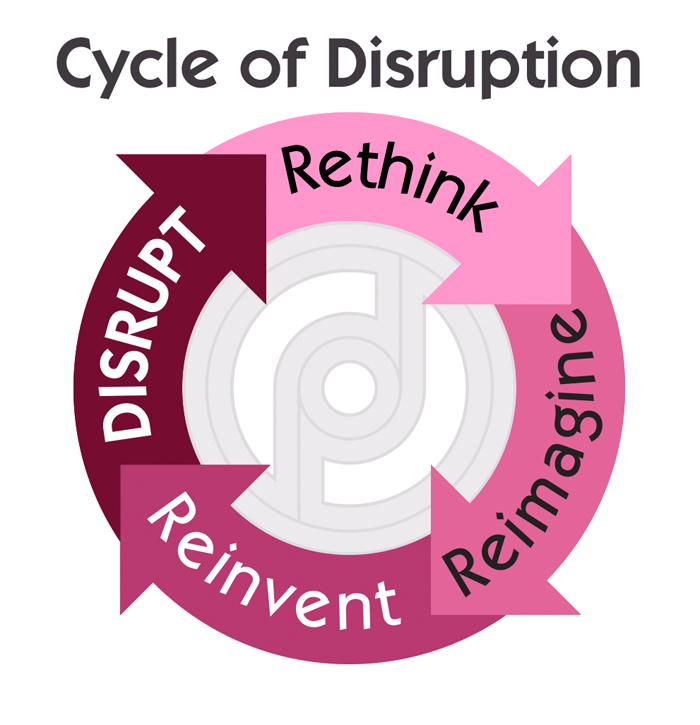
If you’re a small business or startup and launching your new brand, you’ll need to define your brand to your audience. The Personality Profile Performer™Programme empowers you to build your brand so you can become No.1 in your market and increase your profits.
Want to discover more about building your standout, №1 powerhouse brand working with us and leave your competitors way behind?
- Schedule an appointment — we can meet in person or online
- Allow us to create a customised plan for you
- Let’s implement the plan together
- Get in touch [email protected] or ring +353 1 8322724
What is Brand Disruption?
We all know that Airbnb, Uber, and Salesforce are disruptive brands. But what does the term brand disruption or disruptive branding actually mean? Brand disruption is a term that is commonly used in branding and business to describe the break in existing patterns in the market in response to a particularly creative message or product. Here are the three defining elements of brand disruption [1]:
1. Brand disruption is rooted in creativity and innovation
Creativity enables brands to recognize the opportunity and do things differently. Innovation helps create a new market that eventually transforms the existing market. Brand disruption cannot be achieved without creativity and innovation.
2. Brand disruption happens in the present but is focused on the future
For the disruption to happen, brands need to become the beacons of a brighter future. But disruption also can’t be orchestrated without a deep understanding of the present. In that regard, brand disruption transforms the present by changing the current way of doing things and showing us what could be.
3. Brand disruption embraces unusual decisions
Disruptive brands are initially often seen as crazy inventors but all these inventors are trying to cater to the needs of the audience. Brand disruption is characterized by seemingly irrational behaviour, that nevertheless responds to real but hidden needs.
Related: Brand Disruption, Be the Disruptor or Be Defeated
The Two Sides of Brand Disruption
Not every brand with a great idea can become a disruptive brand unless it embraces the new realities of the market. Similarly, the disruptive nature of the current market doesn’t guarantee the instant success of a creative idea.
Disruptive brands use opportunities provided by the market to generate business ideas to disrupt the market. It’s a continuous cycle of assessing the current situation, implementing innovative solutions and then again adjusting the solution to the ever-evolving market needs. Disruptive brands often find themselves in a vicious circle – they trigger market changes by implementing a new business idea, but then they experience extreme pressure to come up with more ideas in order to survive in the market they created.
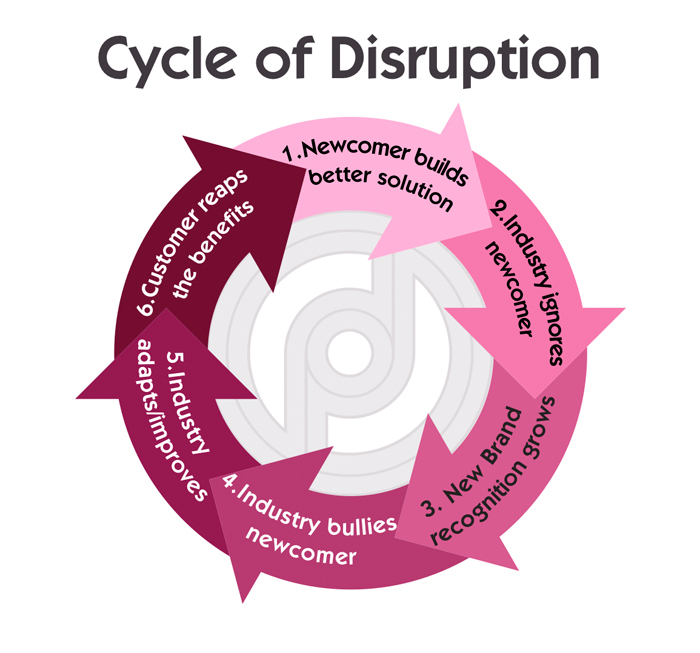
Let’s examine the two sides of brand disruption in detail:
1. External – The New Reality of The Market
The external side includes changes brought to the market by brand disruption and how the new market, in turn, affects business and customers.
Exponential Technology
When it comes to exponential technologies, think cognitive computing, virtual reality and the internet of things. While it has taken some time for these technologies to take off, they are expected to disrupt every industry anytime soon. Exponential technology is the technology that moves from a very slow pace of development to rapid disruptive growth.
Technology has changed our lives but it also changed how the business is conducted [2]. Without embracing exponential technology, no business can survive in the 21st century. Disruptive branding brings forth new technology, facilitates its growth and acquisition, challenges larger businesses, and offers new and unexpected ways to cater to overlooked customer segments.
Related: How Do Challenger Brands Become Market Leaders?
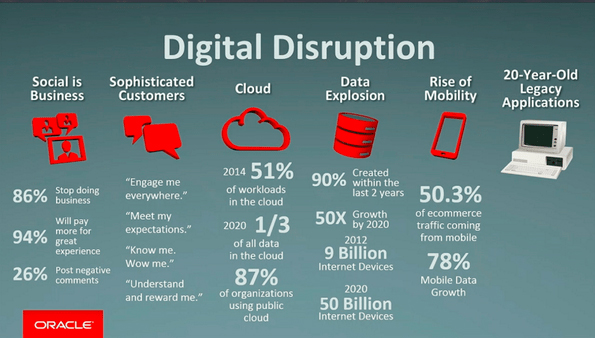
Image via Analyst Consult
Brand and Design Commoditization
Commoditization is the biggest problem facing creative industries right now. As technology becomes more advanced, it slowly takes over functions that were initially perceived as belonging to people, including creative thinking. Additionally, some functions get automated, creating an illusion of instant availability of creativity.
Design commoditization essentially comes down to customer expectations. With the abundance of options and choices available these days, customers simply can’t help but choose the easiest option. So brands that provide great user experience are often favoured over those that are just visually appealing [3].
This doesn’t mean, however, that branding and design are dead. While traditional branding elements such as identity and logo design have been reduced in their importance, a higher branding concept is taking the front row in the business world. Sure, Airbnb’s success can be attributed to the groundbreaking idea of its founders but it’s the brand’s dedication to emotional connection and storytelling that made Airbnb so immensely popular.
Related: Design Is NOT Branding, 10 Things Every Business Owner and Entrepreneur Should Know
Disruptive brands embrace technology and user-friendliness, but they also know how to communicate their value (which sometimes isn’t obvious, especially in the beginning) and tell stories. In the event, you don’t have a disruptive technology to build on, embracing disruptive branding becomes paramount to business’s success.
Check out the recent Tesla video. You can see how the brand is leading with a strong feminist and environmental messages. If you look at most car advertising videos cars you’ll notice that cars are usually driven by men. Tesla is a brand that disrupted the car industry with the help of technology, but they also disrupt societal stereotypes through their branding strategy and marketing communications.
Consumer Expectation For Disruptive Innovation
Consumers expect constant change. When Uber and Airbnb came out, everyone was excited about the new ways to move around and travel, but these two companies have set a very high bar for innovation. Simply implementing a technology in a useful way isn’t enough anymore. When a new startup is created, it’s expected to start a revolution.
There’s a lot of buzz about blockchain technology and virtual reality right now. But once those technologies are developed and widespread, we’ll crave for more innovation. Disruptive brands realize that their position on the market is very volatile. In order to maintain relevance, they embrace being constantly uncomfortable for growth, whether it means further product development or changing their brand narrative.
Overwhelmed by the ever-increasing market demands in the brand disruption era?
We know that sometimes it’s a struggle to build your brand strategy yourselves so we’ve developed three different ways of working with us to help you build your standout powerhouse brand successfully. So depending on your preferences:
- We can build your brand for you – find out more here or get in touch [email protected] or ring +353 1 8322724
- Empower you to build your brand – check out the Persona Brand Building Blueprint™ Mastermind here. This is a two-day intensive where you work on your brand with us codifying and mapping out your brand strategy for business growth. Alternatively, join our half-day Branding Accelerator Masterclass for a fast-injection of brand building essentials
- Want a DIY solution? Check out our ‘How to Audit Your Brand’ eprogramme here and How to Build a Brand eprogramme here
Alternatively, take a look at our Brand Revitalisation service. Some branding does require an extensive change in order for the business to achieve the required regeneration for growth and profitable returns. Revitalisation maintains and celebrates the history and heritage of the brand but shows its target audience (current and future) that you’re still relevant and adaptive to change.
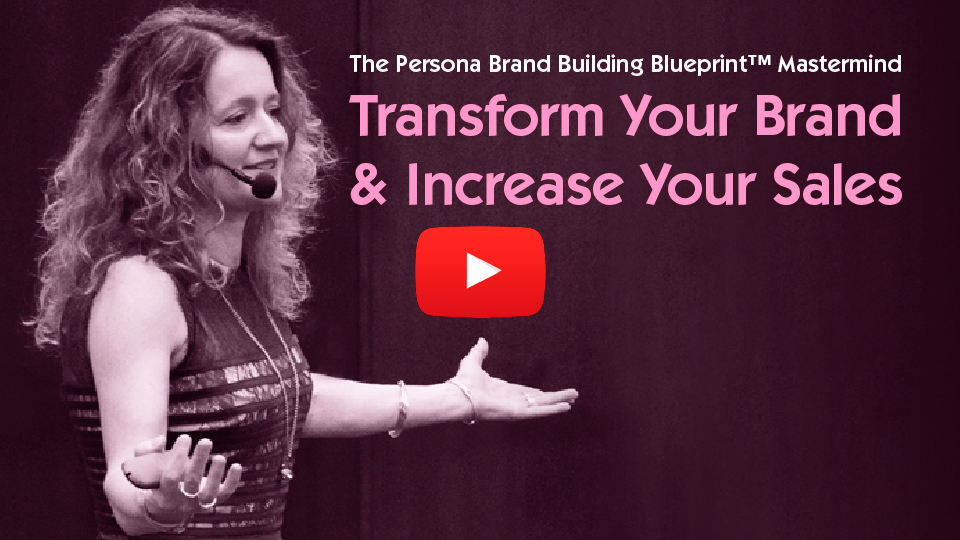
Build your standout brand at the Persona Brand Building Blueprint™ Mastermind with Lorraine Carter
If you want to become empowered to transform your brand so it becomes a disruptive powerhouse enabling you to expand your market and increase your sales then the Persona Brand Building Blueprint™ Mastermind is the perfect fit for you. This is a two-day fast-track brand building intensive, shared with a small group of like-minded peers, where you work on your brand with our leadership to completely re-evaluate it and map it out for growth from the ground up. Discover more here.
2. Internal – The New Reality of Business
While the need to be a disruptor is often dictated by the market, it’s not a one-way street. Business affects the market as much as market affects business. The internal side of brand disruption includes changes that brand disruption brings to the ways businesses operate and how the market perceives such changes.
New Business Models
Business is built around long-standing beliefs on how to make money. In a disruptive age, established business models become obsolete. Brand disruption forces businesses to look at profitability from a different perspective. For example, Udemy challenged our preconceived notions about how education can be organized and acquired. Disruptive brands are often outsiders [4], who see industry rules as fluid and thus can devise better ways to conduct business and make money.
In the market, a disrupter is usually greeted with respect and adoration, while the incumbents are shamed for trying to withhold the power. New ways to conduct business lead to lower product prices so disruptive brands often enjoy limitless customer love. On the other hand, new business models are partly responsible for commoditization, including commoditization of creative industries. So while one type of market players – the consumers – react positively to disruptive brands, another type of players – the incumbents – react negatively. The old players are forced either to leave the market or opt for a brand refresh.
Related: The Power of Disruptor Brands and Challenger Brands
Useful Products vs Consumerism
Another way businesses disrupt the market is through establishing new ways of relating to products. Check out this video from Patagonia. The active lifestyle brand offered their clients clothing repair services. Ultimately, Patagonia is rejecting the idea that customers need to buy new clothing. Thus the old way of attracting consumers and making a sale has been replaced by a new and more sustainable way. Even though the brand isn’t selling new clothes, it doesn’t seem like Patagonia is experiencing financial troubles, as it was able to attract a large base of environmentally conscious consumers who prefer repaired clothing to new items.
Disruptive brands question our lifestyle choices. They make us see the world from a different point of view, instill new behaviour and show us the positive effects of new behaviour.
Everlane has done this too with their eco-conscious clothing line. Have we ever thought about buying eco-friendly clothes before? Certainly, we did, but Everlane as business made us believe that business should be responsible for its impact. The brand changed how consumers think about clothes shopping and now consumers are pushing the exact same message back to business, demanding more useful and environmentally safe products.
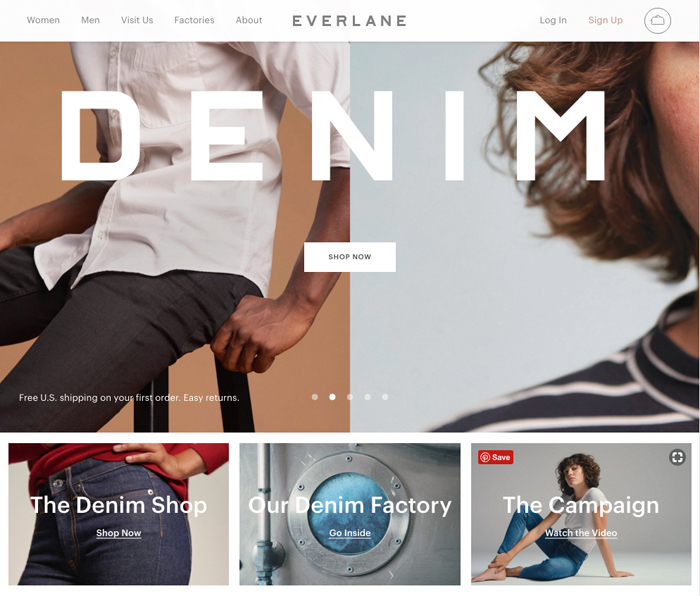
Image via Everlane
Strong Customer Focus
Customer experience has become as important as the actual service or product. And disruptive brands have played a huge role in making this happen. Customer expectations are higher than ever because brands like Amazon and Zappos are pushing the boundaries of what business can give to its customers.
Disruptive brands always look for ways to improve things. If your business doesn’t deliver the best customer experience, you’re already losing the game. But simply trying to keep up with others isn’t enough. Your brand has to offer new and unexpected ways to cater to customer needs and expectations, thereby raising the bar for every business even higher.
Brand Democratisation
Technology has brought luxury services and products to the masses. Additionally, it has changed the way we perceive the word “luxury”. Luxury used to be very expensive and was a sign of status. Nowadays, luxury is something that makes life easier, more enjoyable and allows you to explore your passions. But luxury items no longer have to be expensive.
Disruptive brands break into luxury space, while luxury brands make an effort to appeal to the masses and be more accessible.
Related: 7 Powerful Components Of A Lasting Luxury Brand
We all have a certain hierarchy of thoughts, emotions, and concepts in our minds.
Disruptive brand shows us that some of these concepts aren’t true. Brand democratisation is based on the ability of brand disruption to create new mind maps that customers then internalise and follow.
Disruptive Branding Case Studies
Atom Bank is a mobile app that uses voice recognition and selfies to confirm access. You can open an account online in a matter of seconds. Atom Bank doesn’t have physical branches, which enables them to reduce costs which are in turn passed on to customers.
Atom Bank recognizes customers needs for simple yet affordable and accessible banking experience. The company puts a lot of effort into making a customer journey easier while also challenging the old traditional players in the banking industry.
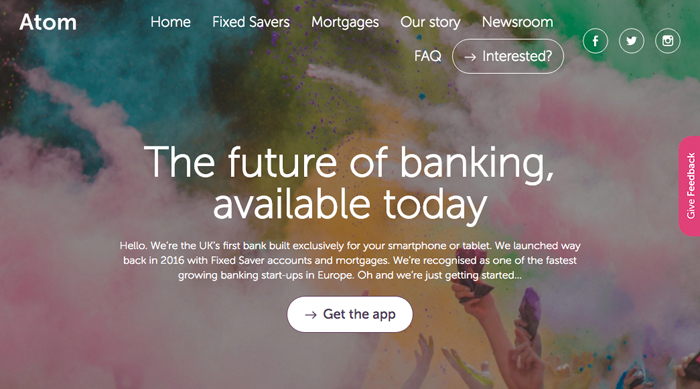
Image via Atom Bank
Essentially, Atom Bank leverages technology to change and democratize a very traditional industry.
We’ve all faced a dilemma of having to buy flowers for a special someone while being inundated with hundreds of tasks on our plates. Even when we have time to send a bouquet it would usually require for the recipient to be at home. Bloom and Wild solves this dilemma with a creative brand promise. You can order the flowers online and then ship them in an award-winning packaging solution right to the recipient’s door. Unlike regular flower delivery brands, Bloom and Wild delivers flowers in cardboard boxes that one can slip straight through the door.
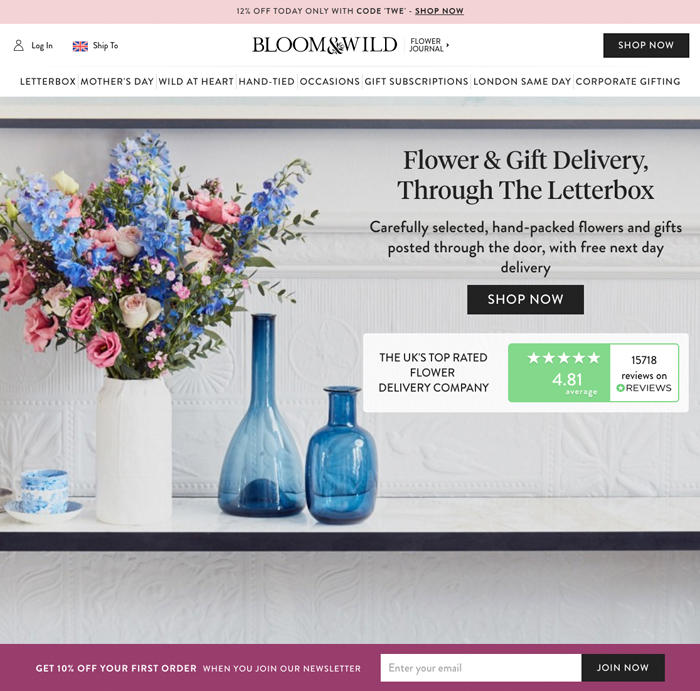
Image via Bloom and Wild
The brand is disrupting the flowers delivery industry with a better and faster way for consumers to meet their everyday needs.
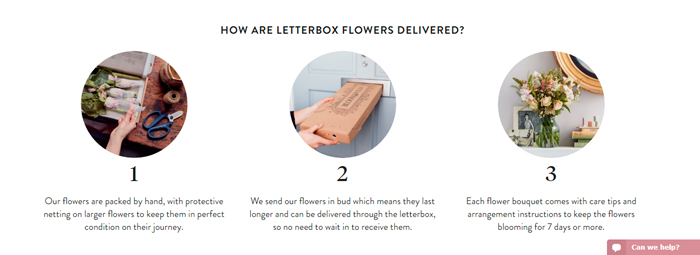
Image via Bloom&Wild
Adaptavate is a construction company that produces ecologically friendly construction products. This is a perfect example of a brand that responded to the growing customer demand for environmentally friendly product alternatives. The company claims that its products outperform conventional products, whilst being good for people and planet.

Image via Adaptavate
Social consciousness is not a new tactic. Many brands nowadays endeavour to have a social responsibility storyline, but Adaptavate applied this storyline to an unusual industry because no one ever expected for our homes to become fully compostable.
Related: Social Responsibility, How to Build a Socially Conscious Brand
Casper is an online mattress company that delivers mattresses directly to your door. What makes the Casper case interesting is that with the help of social media, video marketing and word of mouth, Casper turned a boring task of buying a mattress into a cool experience that you tell your friends about.
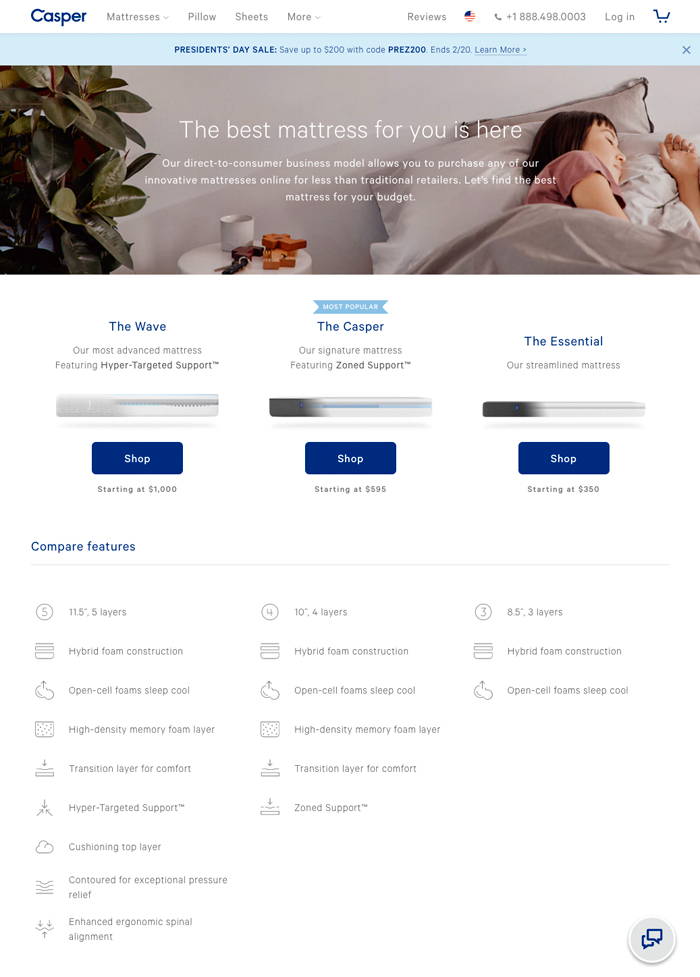
Image via Casper
Additionally, Casper taps into the power of technology to connect people. The brand recently launched Insomnibot-3000 – a chatbot that entertains people who can’t sleep.
Casper is a disruptor brand that changed the way we perceive a tedious chore such as buying a mattress.
How to Become a Disruptor Brand?
Even though disruptive brands can be found in almost every industry and market segment, they aren’t as different from each other as they may seem. There are certain common attributes that disruptive brands exhibit [5].
Here are the four characteristics you need to acquire to become a disruptive brand:
1. Develop a Strong Compelling Brand Purpose
Disruptive brands are often founded by people who believe in the abundance of opportunities. These are Millennials who are very comfortable with technology and believe they can always do better. They are driven by a strong sense of purpose and desire to improve. Their innate ability to identify opportunities and see areas for improvement lead to the creation of unique business ideas.
Related: Purposeful Brands, Why Customers Are Prepared to Pay More
2. Embrace Technology
Disruptive brands make our lives easier with the help of technology. Technology is often the most effective way to improve the current ways of doing things, so it’s no wonder that disruptive brands resort to technology in their quests to realize their business ideas.
Disruptive brands use technology not only for the product creation but in other business areas as well. Logistics, marketing, customer service – disruptive companies build their brands on technology and the notion of disruption in every possible way.
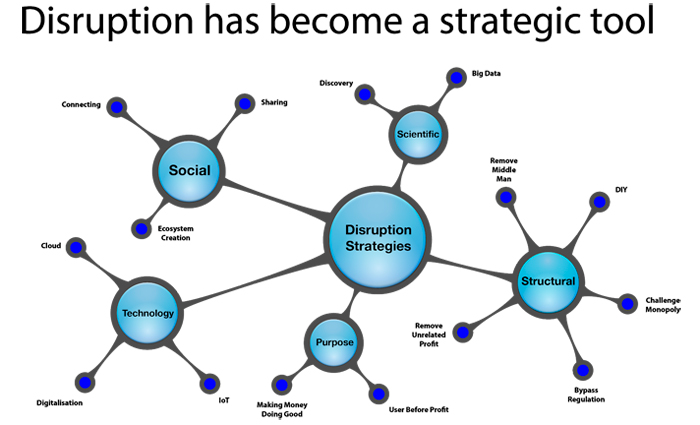
Image via Semiconductor Business Intelligence
3. Be Approachable
Not so long ago brands connected with customers through the signs of power. First stamps and signs, then logos were used to communicate trust and safety. Nowadays, online communication offers a direct access to brands, which forces brands to adjust their strategies and tactics. Since brands are now closer to customers, they have to become more open, emotional and approachable. Disruptive brands communicate trust through open communication and collaboration.
This trend affects how disruptive brands use branding and design. They favour simple colours, patterns, and visuals, and pull people with stories instead of pushing marketing messages out onto the market.
Related: Brand Stories, 5 Compelling Examples That Sell Themselves
4. Put Your Customer At The Core of Your Brand Strategy
From being completely open in social media to adjusting the product based on customer feedback, disruptive brands make every effort to respond to customer needs.
A lot of disruptive brands start off by addressing unknown customer needs, so it’s fair to assume that their initial success is determined by customers. When these brands achieve a coveted dominating spot on the market, they need to keep recreating experiences that showcase brand personality and resonate with the customers.
Final Word
Brand disruption isn’t possible without innovative and creative thinking. Nowadays in order to be successful, you have to embrace the challenges of the new market and then challenge the market yourself. It’s a continuous loop of innovation that requires creative application of all the available tools and technologies. In this never-ending pursuit of new and novelty, brand strategy becomes an inherent part of business’s success because it combines a deep understanding of customer psychology with the ability to break the conventions of industry and offer something substantially new.
Related: Use Psychology in Your Brand Strategy to Create Irresistible Brand Experiences and Increase Sales
Launching a disruptive startup or scaling an established business and want to make your brand stand out? Want a highly recognised and much-loved name?
Then the Persona Brand Building Blueprint™ Mastermind is the perfect fit for you. This is a two-day fast-track brand building intensive, shared with a small group of like-minded peers, where you work on your brand with our leadership to completely re-evaluate it and map it out for growth from the ground up. Discover more here.

Build your standout brand at the Persona Brand Building Blueprint™ Mastermind with Lorraine Carter
Want a DIY brand building solution? Then Personality Profile Performer™ programme is the best fit for you because it will enable you to map out the blueprint or roadmap for your brand so you have a strong brand building strategy aligned to your business goals now and into the future.
If, on the other hand, your brand is struggling under the pressure of brand disruption it might be the time for a brand refresh. Brands need to stay relevant to their target market, to keep up with the times and keep pace with changing customer needs (e.g. services, accessibility, convenience, choice, changing trends, technology). A brand refresh re-evaluates the whole business and gives a company, product or service, a new image, purpose and focus to make it more successful.
Want to discover more about building your standout, №1 powerhouse, disruptor brand working with us so you can increase your profits and leave your competitors way behind?
- Schedule an appointment — we can meet in person or online
- Allow us to create a customised plan for you
- Let’s implement the plan together
- Contact us [email protected] or ring +353 1 8322724 (GMT Dublin/London time 9:00 – 17:30 weekdays)
Questions to Consider
- What are the industry rules that everyone has complacently come to accept? What can be done to defy those rules and re-write them?
- What’s the shortest path to customers? How can you get there fast and offer the best customer experience?
- What can you offer that no one else does?
- How are you making disruptive branding and brand purpose central to your brand’s raison d’etre?
- If you can’t change your product how can you change perceptions around your brand, your brand story, strategy and customer experience to make it contradict competitor stories?
Your Client Satisfaction Guarantee
- When you work with us we’ll create a customised brand building plan and strategy with clear investment for you tailored to your specific requirements and preferences
- You’ll know each step of your brand building journey before we start because we’ll discuss it, document it and agree on it with you before work commences
- You’ll have timelines, key milestones and deliverables to evaluate and approve for each stage and part of your brand building process
- Because we know the unexpected sometimes happens we can make adjustments along the way if you need it and if something extra is requested we’ll ensure you’re fully appraised about what that entails before committing
- As we achieve pre-agreed objectives you’ll be able to evaluate your brand building work and strategy in progress, coupled with the outcomes to ensure return on investment
Get in touch today because we’d love to get started helping you build your standout, powerhouse brand so you can increase your profits and leave your competitors way behind. Email us [email protected] or ring us +35318322724 (GMT 9:00-17:30) and ask about our VIP Brand Strategy Discovery.
Sources:
1. https://www.brandingstrategyinsider.com/2017/01/disruptive-marketing-defined.html#.WomP_ajFLIU
2. https://www.amazon.com/Inevitable-Understanding-Technological-Forces-Future/dp/0143110373
3. http://adage.com/article/guest-columnists/challenger-brands-matter-age-disruption/306053/
4. https://www.amazon.com/Play-Bigger-Dreamers-Innovators-Dominate/dp/0062407619
5. https://www.linkdex.com/en-gb/inked/the-dangers-of-industry-disruption-why-brands-must-think-like-startups/
About
Persona Branding & Design Consultants
Contact: Lorraine Carter
T: +353 1 832 2724
Carra House
Howth, Co. Dublin, Ireland
Copyright © 2007-2022 All rights reserved.
Persona Design Consultants Ltd.
Registered in Ireland: No. 201997
Member of


